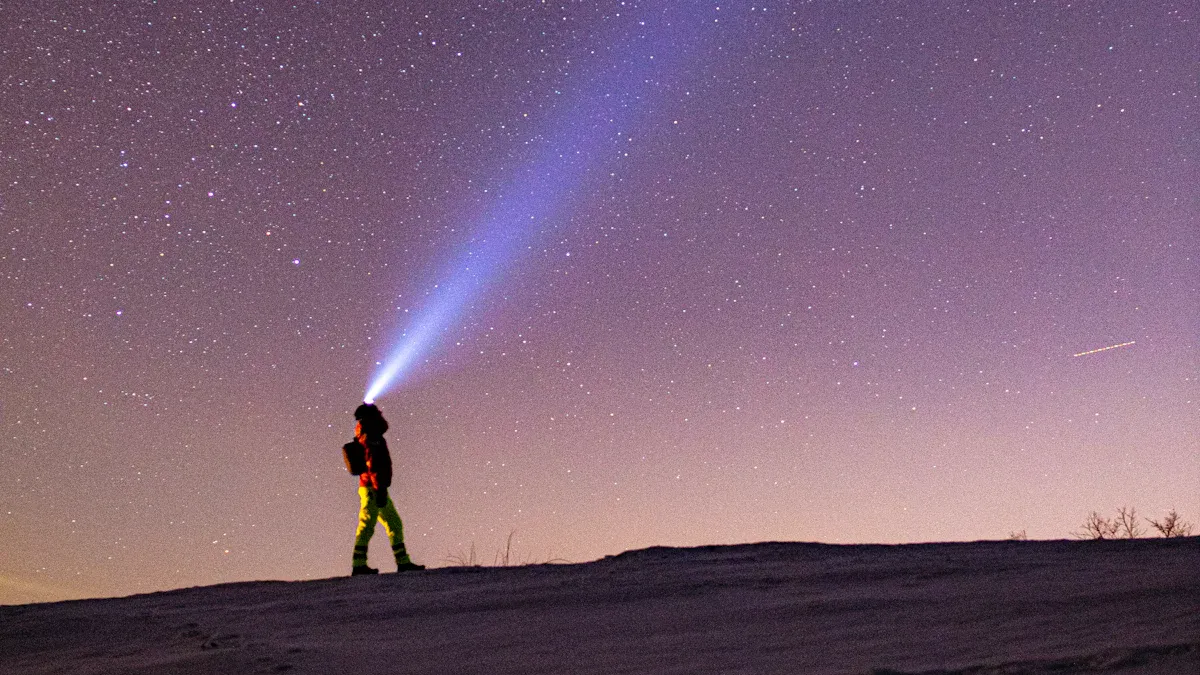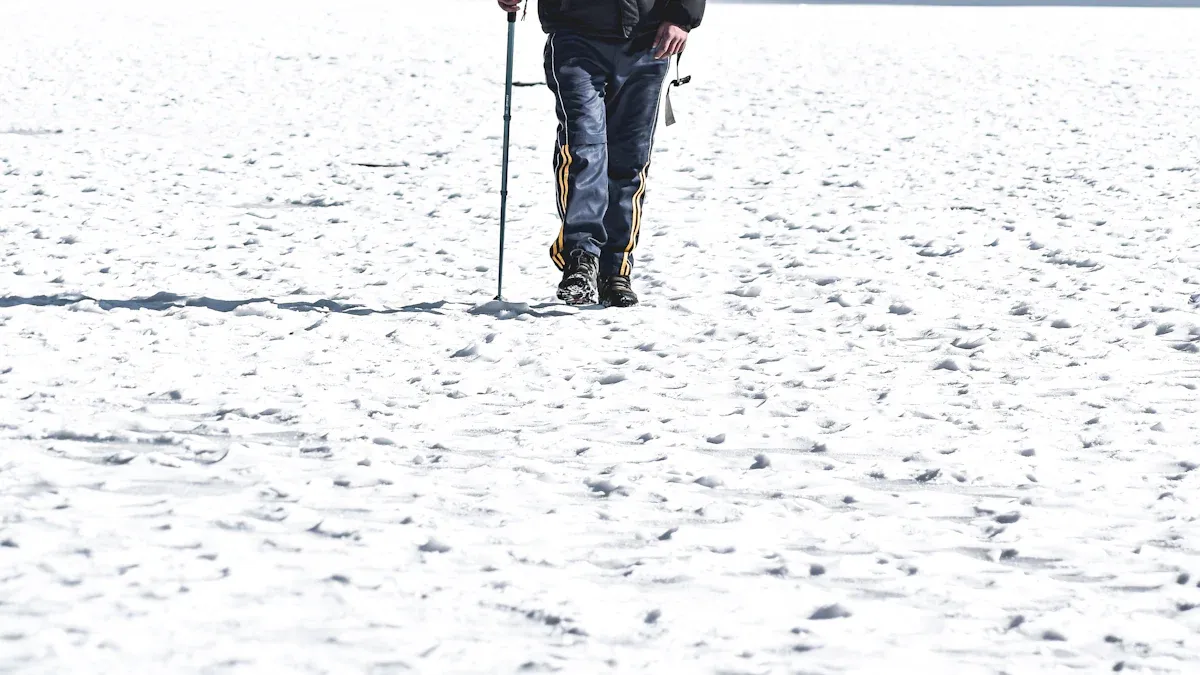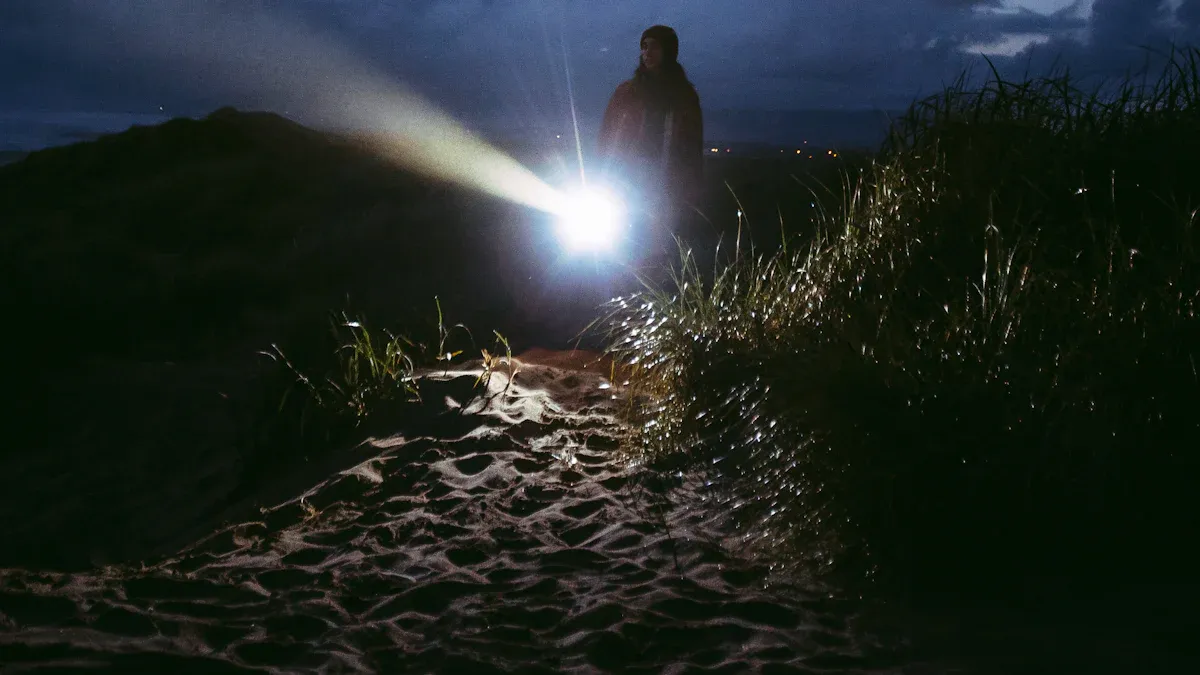Essential Headlamps and Flashlights for Running and Hiking at Night

Running or hiking at night can be thrilling, but it comes with its challenges. Staying visible and safe should always be your top priority. The right lighting gear makes all the difference.
It ensures clear visibility, helping you navigate tricky trails.
Hands-free options let you focus on your activity without distractions.
Better visibility reduces accidents, giving you the confidence to tackle any terrain.
Whether you're using a headlamp or a helius flashlight, reliable lighting gear keeps you prepared for the unexpected.
Key Takeaways
Pick lights with 200 to 1000 lumens for your needs. More lumens help you see better in the dark.
Go for light and comfy headlamps or flashlights. Ones under 6 ounces work best for long hikes or runs.
Bring a spare light and extra batteries with you. This keeps you safe if your main light stops working.
Key Features to Look for in Lighting Gear
When you're choosing lighting gear for nighttime adventures, it's important to focus on features that match your needs. Here's what you should keep in mind:
Brightness and Lumens
The brightness of your headlamp or flashlight is measured in lumens. For most activities like running or hiking on regular trails, 200 to 300 lumens work well. If you're tackling rough terrain or need extra visibility, go for 500 to 1000 lumens. A higher lumen count ensures you can see clearly, even in complete darkness. For tasks like reading maps or navigating shaded areas during the day, a lower lumen range of 100 to 150 is enough.
Battery Life and Rechargeability
Battery life can make or break your experience. Rechargeable models are a great choice because they’re cost-effective and environmentally friendly. You won’t need to keep buying disposable batteries, and many rechargeable options come with USB charging, making them super convenient. Plus, they often last longer and deliver better performance. If you’re planning a long trip, always check how many hours the battery will last on different brightness settings.
Weight and Comfort
Comfort matters, especially if you’re wearing a headlamp for hours. Lightweight models, ideally under 6 ounces (180 grams), are perfect for running or hiking. They stay stable and won’t cause chafing. Look for adjustable straps or padded headbands to ensure a snug fit without discomfort.
Waterproofing and Durability
Outdoor adventures can be unpredictable. That’s why your lighting gear should be durable and weather-resistant. Check for an IP rating to ensure it can handle rain or accidental drops. A rugged design will also protect your gear from wear and tear during tough hikes.
Beam Distance and Lighting Modes
Beam distance determines how far ahead you can see. For hiking, a longer beam is helpful to spot obstacles early. Many headlamps and flashlights offer multiple lighting modes, like flood beams for wide visibility or spot beams for focused light. Some even include red light modes or SOS signals for emergencies, which can be lifesavers in tricky situations.
Tip: Always test your lighting gear before heading out to make sure it meets your needs.
Best Light for Running at Night

Finding the best light for running at night can make your nighttime running experience safer and more enjoyable. Whether you're jogging through city streets or tackling rugged trails, the right headlamp ensures you stay visible and confident.
Top Headlamps for Nighttime Running
When it comes to nighttime running, some headlamps stand out for their performance and reliability. Here are a few top-rated options:
Petzl Nao RL: Perfect for ultrarunners, this headlamp features Reactive Lighting technology that adjusts brightness automatically based on your surroundings. Its battery lasts all night, and replacements are quick and easy. However, it’s not the most comfortable option and comes with a higher price tag.
Black Diamond Sprint 225: Lightweight and compact, this headlamp is ideal for short runs. It offers 225 lumens of brightness and a secure fit, ensuring it stays in place while you move.
BioLite HeadLamp 750: This model provides a powerful 750 lumens and multiple lighting modes. It’s great for longer runs and offers a comfortable, no-bounce design.
Lightweight and No-Bounce Options
For runners, comfort is key. You don’t want a headlamp that feels heavy or bounces with every step. Look for models designed with lightweight materials and secure straps. The BioLite HeadLamp 750 is a fantastic choice, weighing just 5.3 ounces. Its snug fit ensures it stays put, even during intense runs. Another great option is the Petzl Bindi, which weighs only 1.2 ounces. It’s so light, you might forget you’re wearing it!
Budget-Friendly Picks for Runners
You don’t need to spend a fortune to get a reliable headlamp for running. Here are some affordable yet effective options:
Headlamp Model | Price | Brightness | Range | Battery Life |
|---|---|---|---|---|
Fenix HL18R-T Rechargeable | $72 | 500 lumens | 82 m | 8 hours |
Nitecore NU25 UL | $37 | 400 lumens | 64 m | 5 hours |
Petzl Bindi | $50 | 200 lumens | 36 m | 3 hours |
Each of these models offers great value for its price. The Nitecore NU25 UL is particularly popular for its balance of brightness and affordability, making it a favorite among budget-conscious runners.
Tip: Always test your headlamp before heading out to ensure it fits comfortably and provides the right amount of light for your run.
Best Flashlights for Hiking in the Dark

When you're hiking at night, a reliable flashlight can be your best companion. Unlike headlamps, flashlights offer greater brightness and flexibility, making them perfect for illuminating your surroundings. Here's what you should look for when choosing the best flashlight for your nighttime adventures.
High-Lumen Flashlights for Night Hiking
If you're hiking in complete darkness, a high-lumen flashlight is a must. LED flashlights are especially effective because they provide exceptional brightness, ensuring you can see every detail on the trail. Models with over 2,000 lumens are ideal for spotting distant objects or searching for lost items. They also project a powerful beam, which helps you navigate tricky paths with ease. Whether you're exploring dense forests or rocky terrains, a high-lumen flashlight ensures you stay safe and confident.
Durable and Waterproof Models
Durability is key when you're out in unpredictable weather. Look for flashlights with waterproof ratings like IPX6 or IPX8. These models can handle rain, splashes, or even temporary submersion. For example, Klarus Tactical Flashlights are built with tough aluminum bodies and offer excellent water resistance. They also feature long burn times, making them perfect for extended hikes. A durable flashlight ensures you won't be left in the dark, no matter the conditions.
Compact and Easy-to-Carry Options
A compact flashlight is a game-changer for hikers who value portability. Lightweight models like the Ledlenser MT10 and ThruNite Archer 2A V3 are easy to carry and pack a punch in terms of performance. The Ledlenser MT10 offers 1,000 lumens and a beam distance of 180 meters, while the ThruNite Archer 2A V3 is smaller and more affordable, with a runtime of up to 51 hours. Both options are perfect for hikers who want powerful lighting without the bulk.
Tip: Always carry a backup flashlight or extra batteries to avoid being stranded in the dark.
Tips for Using Lighting Gear Effectively
Proper Positioning for Maximum Visibility
Positioning your lighting gear correctly can make a huge difference when navigating trails at night. For headlamps, adjust the angle so the beam points slightly downward. This helps you see the trail ahead without blinding others. If you’re using a flashlight, hold it at waist level to reduce shadows and improve depth perception. For early morning training runs, consider pairing a headlamp with a handheld light. This combination enhances visibility and ensures you spot hazards like roots or rocks early.
Tip: Test your setup before heading out to ensure the light covers your path effectively.
Carrying Backup Lighting Options
Always carry a backup light. Batteries can die, or your primary light might fail unexpectedly. A compact flashlight or a lightweight headlamp works well as a secondary option. For nighttime adventures, pack extra batteries or a portable charger if your gear is rechargeable. This small precaution can save you from being stranded in the dark.
Adjusting Lighting for Different Terrains
Different terrains require different lighting strategies:
Use 100-300 lumens for a balance of brightness and battery life.
Adaptive lighting adjusts automatically, conserving energy and improving visibility.
Avoid overly bright lights that cause tunnel vision.
Add a waist light to enhance depth perception.
Match the light color to the terrain for better contrast.
These adjustments help you navigate trails safely during nighttime or early morning training runs.
Maintenance and Care for Longevity
Taking care of your lighting gear ensures it lasts longer. Here’s how:
Grease rubber seals with silicone to prevent water damage.
Clean battery contacts with rubbing alcohol for stable connections.
Store your gear in a cool, dry place and remove batteries during long storage.
Inspect for wear regularly and clean the exterior to maintain functionality.
Proper maintenance keeps your gear reliable for every nighttime adventure.
Choosing the right lighting gear is essential for safe and enjoyable nighttime adventures. Keep these tips in mind:
Match your light to the terrain for better navigation.
Pick a comfortable, weather-resistant option that fits well.
Ensure the battery lasts as long as your activity.
Use adjustable brightness to adapt to changing conditions.
High-quality lights prevent accidents, improve visibility, and help you explore confidently. With the right tools, you can embrace the thrill of running or hiking at night while staying safe. So, gear up and enjoy the journey! 🌟
FAQ
How do you choose the right headlamp for running or hiking?
Pick a headlamp that fits snugly, offers adjustable brightness, and has a long burn time. Lightweight models with weather resistance work best for all-night adventures.
Can you use a headlamp flashlight combo for outdoor activities?
Yes! A headlamp flashlight combo gives you flexibility. Use the headlamp for hands-free tasks and the flashlight for focused lighting when needed.
How long should a headlamp battery last?
A good headlamp should last at least 5-8 hours on medium settings. For extended trips, choose models with rechargeable batteries or carry spares.
See Also
Why Hunting Flashlights Are Crucial For Outdoor Adventures
A Comprehensive Guide To Selecting Flashlights For Hiking
SF1 Camping Flashlight: Light Up Your Outdoor Experiences
